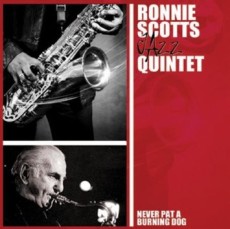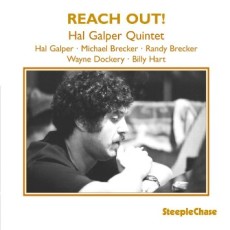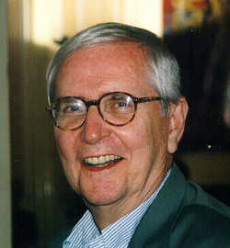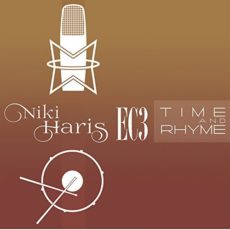
Daily Dose Of Jazz…
Vera Auer was born on April 20, 1919 in Vienna, Austria, the grandniece of violinist Leopold Auer. She learned classical piano and later accordion. In 1948, along with guitarist Attila Zoller formed a combo. She later added vibraphone to her list of instruments and teamed with Helmuth Zukovits on bass and Franz Mikuliska on drums.
In 1950 the group performed and recorded under her own name and appeared on the Austrian radio AG RAVAG. 1951 saw the band The Audience Award for best combo at the taking was the band at the Vienna Jazz Competition. This was followed by her first tour abroad in Turkey and West Germany, where they also played with Friedrich Gulda.
Vera would go on to play with Joe Zawinul, Hans Salomon and Toni Stricker in her band. By 1954 she was playing mainly in West Germany due to poor working conditions for jazz musicians in Austria. She accompanied Donald Byrd, Lucky Thompson and Art Taylor. In 1956 she performed with Jean-Louis Chautemps at the German Jazz Festival.
In 1959 after marrying Brian Boucher and moved to the United States the next year. She attended the Lenox School of Jazz studying under Gunther Schuller, John Lewis and George Russell. She played with Dave Burns, Cal Massey, J. J. Johnson, Mal Waldron, Ted Curson, Zoot Sims, Walter Perkins and Richard Williams. Around 1970, she recorded as a leader an LP titled Positive Vibes with her quintet, which wasn’t released until 1977 and still amazingly fresh sounds.
She continued to perform into the Nineties on the Jazz Mobile and Jazz Vespers of St. Peter’s Church in New York City. In 1984 the American Public Broadcasting Service Program dedicated a one-hour portrait of her. On August 2, 1996 vibraphonist Vera Auer passed away in Newsane, Vermont.
More Posts: vibraphone

Daily Dose Of Jazz…
Dick Pearce was born April 19, 1951 in Forest Gate, London, England. Dick began playing cornet at the age of 12 in the Boys’ Brigade and joined Ewell village’s local brass band a year later. At 15 he became interested in jazz and attended a Sunday morning rehearsal band run by the dance bandleader Ken Macintosh. Soon after, he joined Bill Ashton’s National Youth Jazz Orchestra where he met many like-minded young musicians.
At 17 he spent three and a half extremely disillusioned years in the army (The Household Cavalry) supposedly as a bandsman. He’d played Haydn’s Trumpet Concerto for his audition and expected to receive musical tuition after signing on the dotted line, but for most of his service he found himself sitting on a horse playing bugle calls. Discharged from the army in April 1972, he began playing with some of the ‘freer’ bands of that time – led by Graham Collier, Dudu Pukwana, Pat Evans and Keith Tippet.
In the mid to late 70s he was drawn towards the harmonically structured improvisation of post-Bebop playing with jazz groups led by the likes of Don Rendell, Michael Garrick and Mike Westbrook, while also playing with his own generation of young jazz musicians.
In 1980 Dick joined The Ronnie Scott Quintet, with whom he travelled all over the world for the following 14 years. The band included pianist John Critchinson, double bassist Ron Mathewson, drummer Martin Drew and Ronnie Scott on tenor sax. In 1990 the quintet became a sextet with the addition of Mornington Lockett on tenor sax.
In more recent years trumpeter Dick Pearce has been playing with Alan Barnes, Don Weller’s Tribute to Cannonball Adderley Band. The Don Weller Big Band. The Tim Richards Great Spirit, the John Williams New Perspectives. Stan and Clarke Tracey’s Ellingtonia, Pete Downes Trio with Dick Pearce and John Critchinson’s tribute to Ronnie Scott band.
![]()
More Posts: trumpet

Daily Dose Of Jazz…
Harold “Hal” Galper was born April 18, 1938 in Salem, Massachusetts. He studied classical piano as a boy, but switched to jazz while studying at Berklee College of Music from 1955 to 1958. He hung out at Herb Pomeroy’s club, the Stable, hearing local Boston musicians such as Jaki Byard, Alan Dawson and Sam Rivers.
He started sitting in and became the house pianist at the Stable and later on, at Connelly’s and Lenny’s on the Turnpike. Eventually, Galper went on to work in Pomeroy’s band.
As his career progressed he worked with Chet Baker, Stan Getz and Nat Adderley and accompanied vocalists Joe Williams, Anita O’Day and Chris Connor. Between 1973-1975, Galper played in the Cannonball Adderley Quintet replacing George Duke.
Performing in New York and Chicago jazz clubs in the late 1970s, around this time, Hal recorded several times with guitarist John Scofield on the Enja label. The decade of the Eighties saw him as a member of the Phil Woods Quintet but left to pursue touring and recording with his own trio with drummer Steve Ellington and bassist Jeff Johnson.
As an educator Galper is internationally known, having theoretical and practical articles appear in six editions of Down Beat magazine. His scholarly article on the psychology of stage fright, originally published in the Jazz Educators Journal, has subsequently been reprinted in four other publications.
Pianist, composer, arranger, bandleader, educator and writer Hal Galper is currently on the faculty of Purchase College and the New School for Jazz and Contemporary Music.
![]()
More Posts: piano

Daily Dose Of Jazz…
Whitney Lyon Balliett was born in Manhattan, New York on April 17, 1926. He was raised in Glen Cove, Long Island and attended Phillips Exeter Academy, where he learned to play drums. There he became part of a band that played “baggy Dixieland” and during the summer played gigs at a Center Island yacht club.
Drafted into the Army in 1946, interrupting Whitney’s freshman year at Cornell University, he returned to finish his degree in 1951. While matriculating he was a member of The Delta Phi Fraternity and after graduating went to work at The New Yorker, hired by Katherine White, one of the magazine’s fiction editors.
Among his many jazz wittings were: Such Sweet Thunder: 49 Pieces on Jazz, Super-drummer: A Profile of Buddy Rich, Alec Wilder and His Friends, Improvising: Sixteen Jazz Musicians and Their Art, Night Creature: A Journal of Jazz 1975-1980, American Musicians: Fifty-Six Portraits in Jazz, American Singers: Twenty-seven Portraits in Song, and Collected Works: A Journal of Jazz 1954-2000.
Acclaimed for his literary writing style, jazz critic, book reviewer and author Whitney Balliett passed away on February 1, 2007, aged 80, from cancer.
![]()
More Posts: writer

Review: Niki Harris & EC3 | Time & Rhyme
Every now and then, if you’re lucky, you run across a bandleader who understands how to make a joyful noise. The days of the solo arranger and set configuration of players have been replaced with diversity bringing new ideas to eleven old songs. On his latest project Time & Rhyme, producer and drummer EC has collaborated with Niki Haris (Gene Harris’ daughter) and together have selected an incomparable set list that is no small feat to honor. Kicking off the set is a Tyrone Jackson arrangement with vocalist Niki Harris swinging an upbeat, straight-ahead version of the Hart/Rodgers tune Falling In Love With Love.
Traveling across the musical landscape Niki again takes center stage to present a poignant and tender rendition of another Jackson arrangement of the Bell/Creed composition Stop, Look, Listen. Not many vocalists have made me sit down and listen as intently as she did with the clarity and beauty of her interpretation. I could attempt to describe the emotional delivery Ms. Haris rendered on this song that five guys out of the Philly sound machine made famous, but the effort would be feeble at best and would be an injustice as you listen to her immense talent.
To challenge oneself to play a master is EC’s forte and he delivers with aplomb Dizzy’s Night In Tunisia opening with a strong bass line and sliding easily into an Afro-Cuban beat that can only be viewed as homage to a rhythm so dear to Mr. Gillespie’s heart. I was immediately transported to the backstreets of Havana and the raucous clubs full of flute, percussion and mambo.
Jackson steps in again with an easy bossa nova arrangement utilizing Frankie Quiñones percussive endowment to compliment Niki’s voice on Abbey Lincoln’s Throw It Away. Interestingly modal, they take it to a middle-eastern groove towards the end of the song, which gives Lincoln’s tune a refreshing outlook.
One can only think of the hapless scarecrow in the Wizard Of Oz when you see the words If I Only Had A Brain. Having heard this catchy Arlen/Yarburg tune many times, I was curious about the arrangement that would set this apart from the pack. Wade Beach set the tone for bassist Zack Pride’s conversation with EC’s drums. One can actually envision walking down the yellow brick road as they playfully execute the melody.
Billy Paul pulled the world’s heartstrings with Me & Mrs. Jones, however, Niki emotes a sense of fun and enjoyment in her relationship with Mr. Jones. One gets the sense that she is as comfortable with the relationship the way it is as she is relating it with an under beat of this collaborative mid-tempo bossa nova arrangement by EC and Jackson. Artia Lockett adds her enjoyment in the background like two girls having fun on a double date.
Not much more than the title needs to be said about Swinging At The Haven. EC puts his foot in the stew on this arrangement and the guys stir it up well. If you aren’t tapping a toe, shaking a hip or snapping your fingers, then you don’t know swing. Let this be your introduction.
Lionel Bart sits alongside the many resident masters of the Great American Songbook having penned the music and lyrics to Where Is Love for the 1960 Broadway musical Oliver. It’s a ballad of a young orphaned lad longing to find someone to love him and Niki quietly portrays the emotional depth of the lyric causing one to sympathize for the plight of this lost waif.
Changing tempos, EC, Dominique Patrick-Noel and A.T. take us back to our roots in the motherland as the trio drums and chants through Black Codes. One can visualize the movements of the dancers in a celebration of raising their ancestors. Nice & Easy is exactly what Niki and company do with this mid-tempo 7/8 meter of straight swing and Afro-Cuban undertones. If an encore was ever warranted on a recording then this Mandel/Mercer classic Emily would be a fitting adieu. The guys maintain the light and airy touch of the composers had in mind, leaving this listener with a vision of blue skies, sundresses, laughter and play in a field of wildflowers. Allow them to take you where your heart wants to go.
On this session drummer Ernest “EC” Coleman enlists vocalist Niki Harris, pianists Tyrone Jackson and Wade Beach, bassists Craig Shaw and Zack Pride, Sam Skelton on tenor saxophone and flute, saxophonist Teddy Baker, percussionists Frankie Quiñones, Dominique Patrick-Noel and Arch A.T. Thompson and Artia Locke holding down the background vocals.
For the uninitiated to EC’s genius, as you listen to this compendium of talent and music, I implore you to keep in mind, these are not shy schoolboys or coy girls on their first date. They are uncompromising professionals who know how to swing as well as be that gentle giant in the room with an equally tender touch. They may make it look easy but it is far from being that simple. Time, patience and the talent of eleven musicians committed to their craft have given birth to this seamlessly entrancing orchestration of sound.
carl anthony | notorious jazz | april 11, 2016
Give A Gift Of Jazz ~ Share ![]()
#preserving genius
More Posts: bandleader,drums,history,instrumental,jazz,music,review,vocal


